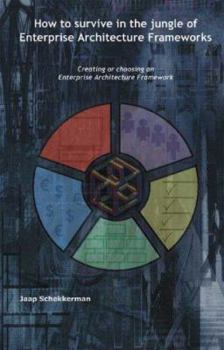How to Survive in the Jungle of Enterprise Architecture Frameworks: Creating or Choosing an Enterprise Architecture Framework
Select Format
Select Condition 
Book Overview
Several times in my Enterprise Architecture (EA) practice, people asked me which framework shall I adopt or what are the benefits of the Zachman framework over TOGAF, etc. Others asked me to help them... This description may be from another edition of this product.
Format:Paperback
Language:English
ISBN:141201607X
ISBN13:9781412016070
Release Date:July 2006
Publisher:Trafford Publishing
Length:224 Pages
Weight:0.62 lbs.
Dimensions:0.5" x 5.7" x 8.0"
Customer Reviews
2 ratings
starts slow - ends strong
Published by Thriftbooks.com User , 20 years ago
At first glance of this book the typos and alternate spellings gets annoying, but after some acclimating the information starts to sink in very easily. Each Framework is explained concisely and doesn't try to get into every detail. There are books for each of the frameworks for that. Overall, I am pleased with it and would suggest it to anyone that is early in their Enterprise Architecture career or anyone that needs to catch up with all the frameworks.
Valuable compendium
Published by Thriftbooks.com User , 21 years ago
When I received this book I quickly scanned it and dismissed it as a niche book for architects working in the US Government or contractors working in that environment. After reading it, though, I believe that this is an invaluable book for enterprise architects in the commercial sector as well.For those working in or with the US Government, and especially the Department of Defense, this book's in-depth comparison of enterprise architectures within that domain is an amazing resource. Among the government- and DoD-specific architectures covered are Federal Enterprise Architecture Framework (FEAF) issued by the CIO council, Command, Control, Communications, Computer Intelligence, Surveillance, and Reconnaissance (C4ISR) Architecture (a part of the Department of Defense Architecture Framework (DODAF), and Joint Technical Architecture. This book also covers CCA architecture compliance. This is an interesting part of the book because lessons learned from CCA compliance requirements may possibly translate into an approach for aligning commercial architectures to Sarbanes-Oxley, which is a hot topic in the commercial sector. Enterprise architectures in the commercial domain that are covered include the Zachman Framework, Enterprise Architecture Planning, The Open Group Architecture Framework, and the Integrated Architecture Framework. More importantly, there are manufacturing-specific frameworks covered, such as the Purdue Enterprise Reference Architecture and the Computer Integrated Manufacturing Open Systems Architecture, which round out this book's comprehensive survey of architectures.The manner in which the above architectures are covered is what I most like about this book. The author has performed the mind-numbing task of collecting relevant factors of each architecture, then presenting them in a set format: history, purpose, scope, principles, structure, guidance and compliance. This format allows you to use this book as a catalog of architectures, as well as the basis for comparing the strengths and weaknesses of architectures that are suitable for a specific environment.I also like the first eight chapters, and chapters 11 and 12, which provide general information about enterprise architectures, definitions, and advice on how to select the best architecture based on requirements.This is an important book for enterprise architects that will serve as an encyclopedia, idea book, and general resource.






